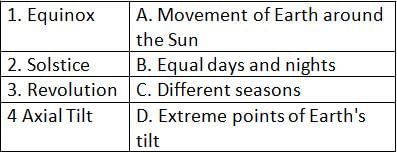Class 6 Exam > Class 6 Tests > Test: Globes and Maps - 2 - Class 6 MCQ
Test: Globes and Maps - 2 - Class 6 MCQ
Test Description
10 Questions MCQ Test - Test: Globes and Maps - 2
Test: Globes and Maps - 2 for Class 6 2025 is part of Class 6 preparation. The Test: Globes and Maps - 2 questions and answers have been prepared
according to the Class 6 exam syllabus.The Test: Globes and Maps - 2 MCQs are made for Class 6 2025 Exam.
Find important definitions, questions, notes, meanings, examples, exercises, MCQs and online tests for Test: Globes and Maps - 2 below.
Solutions of Test: Globes and Maps - 2 questions in English are available as part of our course for Class 6 & Test: Globes and Maps - 2 solutions in
Hindi for Class 6 course.
Download more important topics, notes, lectures and mock test series for Class 6 Exam by signing up for free. Attempt Test: Globes and Maps - 2 | 10 questions in 10 minutes | Mock test for Class 6 preparation | Free important questions MCQ to study for Class 6 Exam | Download free PDF with solutions
Test: Globes and Maps - 2 - Question 1
Match the following Earth motions with their descriptions


Detailed Solution for Test: Globes and Maps - 2 - Question 1
Test: Globes and Maps - 2 - Question 2
The tilt of Earth's axis is approximately ____________ degrees.
Detailed Solution for Test: Globes and Maps - 2 - Question 2
Test: Globes and Maps - 2 - Question 3
Equator is to latitude as Prime Meridian is to ____________.
Detailed Solution for Test: Globes and Maps - 2 - Question 3
Detailed Solution for Test: Globes and Maps - 2 - Question 4
Test: Globes and Maps - 2 - Question 5
Indian Standard Time (IST) is based on the standard meridian at ____________ degrees East.
Detailed Solution for Test: Globes and Maps - 2 - Question 5
Detailed Solution for Test: Globes and Maps - 2 - Question 6
Detailed Solution for Test: Globes and Maps - 2 - Question 7
Detailed Solution for Test: Globes and Maps - 2 - Question 8
Test: Globes and Maps - 2 - Question 9
What do we call a book of maps that contains many different kinds of maps?
Detailed Solution for Test: Globes and Maps - 2 - Question 9
Test: Globes and Maps - 2 - Question 10
What is the imaginary line on which the Earth rotates called?
Detailed Solution for Test: Globes and Maps - 2 - Question 10
Information about Test: Globes and Maps - 2 Page
In this test you can find the Exam questions for Test: Globes and Maps - 2 solved & explained in the simplest way possible.
Besides giving Questions and answers for Test: Globes and Maps - 2, EduRev gives you an ample number of Online tests for practice
Download as PDF
















